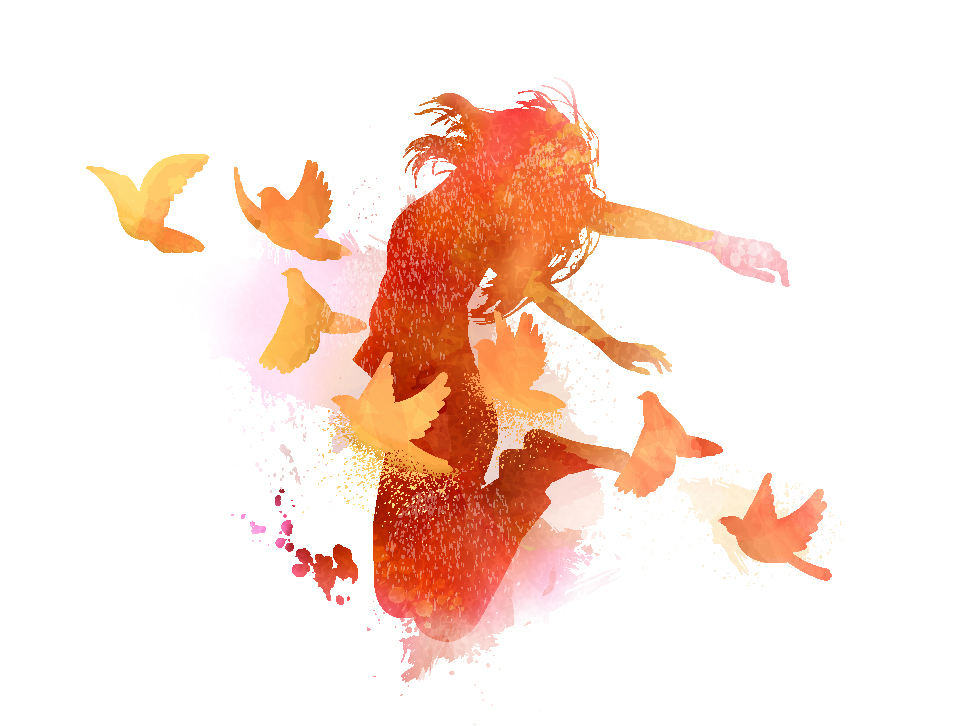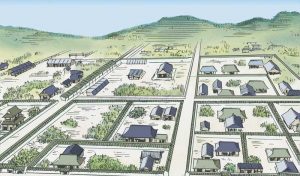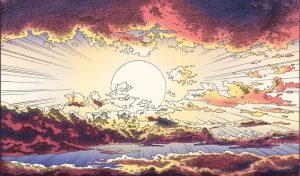Deeply committed to the education and development of children and youth, Ikeda Sensei, as the third Soka Gakkai president, established the high school division in June 1964, the junior high school division in January 1965, and the boys and girls division in September 1965—which together comprise the future division.
The present generation of future division members will be the key protagonists of the kosen-rufu movement when the Soka Gakkai celebrates its 100th anniversary in 2030. With this recognition, the Soka Gakkai monthly study journal Daibyakurenge (starting from its November 2010 issue) launched a series chronicling Sensei’s efforts to foster the future division members, along with graduates’ personal accounts and recollections of meetings and interactions with Sensei in their youth.

The day after Ikeda Sensei’s third lecture to high school division representatives, March 29, 1966, an educators division meeting was held at the head temple’s Grand Reception Hall.
Sensei shared his profound aspirations with the more than 3,000 assembled members there: “I am deeply resolved to dedicate my life to the youth division, the student division and above all, the high school division. I wish to pass the baton of our movement to the youth. Until then, no matter what happens, I will steadily continue to open the way forward, waiting for the right time.”
He then reiterated: “My sole concern is fostering capable individuals. The most important thing is the eternal transmission of the Mystic Law. I am wholeheartedly committed to the Soka Gakkai and kosen-rufu.”
On another occasion, someone asked Sensei, “How would you describe the work of the Soka Gakkai president?”
He replied: “To put it simply, my work involves encouraging people. It could also be described as fostering capable individuals.”
Mieko Kawai (Soka Gakkai women’s division prefecture vice leader): I was employed at the Soka Gakkai Headquarters after graduating from high school, and I had the opportunity to observe Sensei at work firsthand.
He was constantly working, whether it was reading the numerous reports he received, giving out instructions or busily writing. It was like a battlefield. Just as I was thinking to myself, “How does he do all that himself?” Sensei said, as if reading my mind, “Apparently the U.S. president has a hundred advisors and assistants.”
I felt he was expressing his hope for the emergence of many capable people.
■ ■ ■
On April 23, 1966, Sensei’s fourth lecture to high school division representatives took place. The writing from Nichiren Daishonin studied this time was “Letter from Sado” (The Writings of Nichiren Daishonin, vol. 1, p. 301).
The meeting was held at the Soka Gakkai Headquarters in Shinanomachi, Tokyo. As the previous lecture had taken place at the head temple, it was nearly two months since the high school division members had last gathered in the large meeting room [later known as the Mentor-Disciple Hall] on the third floor of the Headquarters.
Kayoko Oyama (Soka Gakkai women’s division national vice secretary): It was two months since Sensei’s last lecture at the Headquarters. I made my way eagerly to the event.
Whenever I walk into the Headquarters, I remember leaving the building after that second lecture, held two months before. I just happened to look back and I saw Sensei standing behind the glass door at the entrance. I bowed quickly, and he bowed deeply in return. I was very moved by his warm sendoff.
Sensei gives us a place, a home to return to and recharge ourselves when we’re struggling.
■ ■ ■
By the fourth lecture, the participants knew everyone’s name and felt comfortable with each other. They became more relaxed and the gathering took on a warm, familiar feeling.
At 3:10 p.m., an energetic voice called out from the back of the room: “Hello everyone! How have you been?”
Sensei had arrived somewhat ahead of schedule.
“Let’s do gongyo together,” he said.
The participants responded enthusiastically to the invitation, and with that, the meeting began.
■ ■ ■
Background to “Letter From Sado”
In this next section, we [the Daibyakurenge editors] will provide some background to “Letter from Sado.”
Nichiren Daishonin nearly lost his life in the Tatsunokuchi Persecution[1] and subsequent Sado Exile. This persecution came about because of vicious false accusations, “not because of any secular crime” (WND-1, 303).
Why was Nichiren persecuted? Because he incurred the envy of corrupt and malicious Buddhist priests. Essentially, hatred and ill will caused by ugly jealousy was the direct trigger for this persecution.
Three months before the Tatsunokuchi Persecution, the priest Ryokan of Gokuraku-ji temple[2] was defeated in a contest with the Daishonin to pray for rain.
Ryokan was respected by the public and had the support of both the military government and the imperial court. But Nichiren revealed the error of Ryokan’s teachings and his personal hypocrisy, exposing him to public ridicule.
Ryokan was no match for the Daishonin—not in respect to the teachings he preached, his personal character or the actual proof of his practice. His only alternative, he believed, was to paint Nichiren as a villain. Consumed by jealousy, he plotted to bring about the Daishonin’s downfall.
Aided by other priests who supported him and employing all possible connections, he spread false rumors about Nichiren and poisoned the authorities against him. He also instigated the wives of high-ranking government officials to have their husbands take action against the Daishonin. These behind-the-scenes machinations of a corrupt priest influenced the ruling authorities, leading to their concentrated persecution of the Nichiren and the oppression of his followers.
Though the Daishonin was fully aware of what was happening, he fearlessly stepped into the midst of the storm.
The people of Japan at the time were anxious and nervous. An invasion by the Mongol forces, an unprecedented threat to Japan’s survival, seemed imminent. They were without hope and deeply uncertain about the future. It was a turbulent and troubled time.
Exploiting this mood of anxiety, corrupt Buddhist priests circulated defamatory rumors about Nichiren, who writes: “My bad reputation has spread throughout the realm” (“The Four Debts of Gratitude,” WND-1, 42). Because of these lies, the public came to see him as an evil Buddhist priest.
Consequently, when false rumors arose in the aftermath of the Tatsunokuchi Persecution, claiming that the Daishonin’s followers had set fires, people accepted them as true without any evidence or proof. Nichiren points out in his writings that even government officials believed the lies (see “The Actions of the Votary of the Lotus Sutra,” WND-1, 769).
By depicting the Daishonin’s followers as an antisocial group, it was easy to justify their persecution. This is typical of the persecution that befalls those who practice the correct teaching of Buddhism.
Public opinion sided with the machinations of the authorities, and Nichiren’s followers were persecuted with impunity.
The Daishonin writes:
My disciples, my lay supporters, and even those who have merely listened to my teachings have been subjected to severe punishment and treated as though they were guilty of treason. (“The Opening of the Eyes,” WND-1, 240)
■ ■ ■
Some of those who are associated with me have had to suffer official punishment, have had their lands confiscated, have been dismissed from service by their lords, or have been abandoned by their parents and brothers. (“Letter to Horen,” WND-1, 519)
■ ■ ■
[This follower’s] entire livelihood depended on a small fief, and that was confiscated because of his faith in the Lotus Sutra. (“Winter Always Turns to Spring,” WND-1, 536)
Amid these circumstances, many people abandoned their faith, demonstrating a hatred for their former teacher even greater than those persecuting and denouncing him. Even more insidiously, these traitors tried to win Nichiren’s still faithful followers to their side.
This attack from the inside, carried out while the Daishonin was away in exile on Sado, struck a serious blow to his community of followers. It reached the point where, Nichiren writes: “In Kamakura, 999 out of 1,000 people gave up their faith [in the Mystic Law] when I was arrested” (see “Reply to Niiama,” WND-1, 469). The community of followers was nearly destroyed.
This is the background against which the Daishonin composed “Letter from Sado.”
His disciples were continuing to face incredible challenges and suffering. They questioned why this was their fate, why they had to suffer so much, and where the meaning was in it all. “Letter from Sado” was Nichiren’s response to their questions.
In the study series “The World of Nichiren Daishonin’s Writings,” Sensei addressed the significance of this persecution, stating: “I think we can also view the Daishonin’s exile to Sado as having signaled the start of a new phase for his disciples—their faith tested and strengthened through the trials of persecution—when they would come into their own and demonstrate their mettle as true disciples.”[3]
■ ■ ■
Sensei then began his lecture on “Letter from Sado.” In this fourth session, they would study the first half of the letter, starting from the line, “This letter is addressed to Toki,” and ending with the passage, “This is the meaning of the passage from the Lotus Sutra that reads, ‘Evil demons will take possession of others’” (WND-1, 301–3). They would study the remainder at the next lecture.
Like the previous lectures, this one proceeded with high school division members reading the passage aloud and then explaining it in modern Japanese, followed by Sensei’s lecture on the passage.
“Letter from Sado” is a writing that the Soka Gakkai has made its own. The first three Soka Gakkai presidents have put this writing into practice with a selfless dedication to faith.
At the outset of his lecture, Sensei spoke briefly of the writing’s background, saying: “Nichiren wrote ‘Letter from Sado’ to his disciples and lay supporters amid the terrible persecution of his exile on Sado Island. It was a time when many of his followers were abandoning their faith.”
He then powerfully stated the writing’s conclusion: “Nichiren Daishonin tells us that times of great persecution are precisely when we must not give up our faith. He assures us that as long as we remain steadfast in faith at such critical moments, we will absolutely attain Buddhahood. That is the essential message of ‘Letter from Sado.’”
Kuniko Nakanishi (Soka Gakkai women’s division nationwide vice secretary; women’s division Study Department leader): During the lecture, Sensei said repeatedly: “You must never give up your faith. Never, under any circumstances. No one in this group must ever do so. Please support each other. If someone seems as though they might stop practicing, please lead them back to the correct path. I am counting on you.”
He taught us that faith is a struggle we carry out throughout our lives, and that it is by surmounting the challenges that make us want to stop practicing that we achieve our human revolution.
■ ■ ■
The lecture then moved on to the actual text of the letter.
Send me the names of those killed in the battles at Kyoto and Kamakura. (WND-1, 301)
In an easily accessible manner, Sensei explained the sentiments that likely prompted Nichiren to make this request, “This letter was written during the time of an uprising within the Hojo clan in Kamakura and Kyoto—an instance of the so-called calamity of revolt within one’s own domain (internal strife) in February 1272—and many were killed in the fighting.
“No doubt some of the Daishonin’s followers who were members of the warrior class also lost their lives in the conflict. Nichiren asks for their names to be sent him so that he can offer prayers for their repose—an expression of his great compassion. Despite the hardship and danger of his own exile on Sado, he was more concerned about chanting Nam-myoho-renge-kyo for the deceased and relieving their suffering.”
Katsuhiro Shirai (Soka Gakkai vice chapter leader): Many years after this lecture, I was working as the site manager for a major construction firm. I had reached a point where I was so busy at work that it was becoming difficult for me to participate in Soka Gakkai activities. I was completely overwhelmed by my responsibilities.
I think that one of the members who attended those lectures with me so long ago must have reported my situation to Sensei, because he sent me a copy of his A Youthful Diary. When I opened it, I found the inscription: “I hope you’re well, Katsuhiro. Please continue advancing energetically forward. That is my only wish, and it will bring me great joy. I pray for your growth. August 2.”
I was overcome with emotion. I understood that Sensei would always continue to warmly encourage each and every one of us.
■ ■ ■
“Letter from Sado” begins with the fundamental question of life and death:
The most dreadful things in the world are the pain of fire, the flashing of swords, and the shadow of death. (WND-1, 301)
Sensei has said that a chill ran through him when he read this passage in his youth. He explains the reason why in one of his essays: “On the night of April 15 [1945], an air raid destroyed most of [my hometown] Kamata. … In those days, it was simply impossible to avoid hearing stories about who had died in the attacks. … But there was nothing for us to do but forge on as best we could, the monster of the war in hot pursuit; each day that we survived was like a miracle.”[4]
War is cruel and barbaric, and we must work to prevent it at all costs.
Sensei said solemnly to the high school division members: “There are two things people fear most. One is ‘the pain of fire, the flashing of swords’—in contemporary terms, war. This includes the atomic bomb. We of the Soka Gakkai are absolutely opposed to war. Everyone fears war. Practicing Nichiren Buddhism, the Mystic Law, is the way to prevent war!”
Shogo Ohashi (Soka Gakkai Writers Division advisor; vice ward leader): At the time, the news carried daily reports of the United States’ bombing of North Vietnam. There were even fears that war might break out between China and the U.S.
Sensei taught us that war and nuclear weapons, the greatest threats to life, are to be opposed at all costs. Six months later, he issued a proposal for peace in Vietnam (at the 15th Youth Division General Meeting, held on November 3, 1966). He was engaged in an intense verbal campaign for peace, setting an example for us through his actions.
Sensei continued, “The second thing that people fear is ‘the shadow of death’—in other word, their lives ending.”
Death is frightening. Yet it is something we will all experience. It is one of life’s fundamental sufferings. How can we come to terms with this unavoidable suffering?
Sensei said: “Nichiren’s teachings shed light on and resolves this fundamental question.”
■ ■ ■
Upholding faith in Nichiren Buddhism provides the answers to life’s mysteries. So how do we resolve the question of existence and the suffering of death?
The lecture moved on to the passage that provides the answer.
“Since nothing is more precious than life itself, one who dedicates one’s life to Buddhist practice is certain to attain Buddhahood.” (WND-1, 301)
The key is to transform our suffering into empathy, to change our sorrow into compassion.
Sensei said: “The Daishonin is encouraging us to chant to the Gohonzon, devote ourselves to the happiness of others and chant to the last moment of our lives. Then, an eternal and vibrant life-force will well up from within us. As long as we maintain such a spirit, our lives are certain to improve.” And he added humorously, “See, aren’t you glad you encountered Nichiren Buddhism?”
Sensei encouraged his listeners not to waste their precious lives.
Addressing the young men, he then remarked: “The Daishonin states: ‘A man will die to defend his honor’ (WND-1, 301). Nowadays, there are very few men who will give their lives for honor. People don’t seem to mind disgracing themselves!” [Laughter.]
He then addressed the young women: “Nichiren also says: ‘A woman will die for a man’ (WND-1, 301). Be careful about that. Don’t be foolish and throw your life away for an unworthy man. Never forget that the only thing you can trust absolutely is the Gohonzon.”
To the entire audience, he added, “Never throw your life away for superficial things.”
■ ■ ■
Masaichi Ueda (Soka Gakkai senior advisor; former national high school division leader and national young men’s division leader): I attended the lecture as the leader of the high school division. Sensei also said to the young men: “The most dangerous time for men is their 30s and 40s. That’s the time when they have the least money, but need it the most. Don’t lose your way in those years by letting greed or ambition get the better of you.”
He was driving home to us that we must never stray from our chosen path in life. His strictness came from his concern for our futures.
Yahiro Ryokaku (Soka Gakkai vice district leader): Sensei said: “Men’s true worth comes from their ability to be both strong and compassionate. Those qualities, however, need to be backed up by a solid Buddhist practice.” He also said, “A man impresses others when he is sincere and earnest.” It was a perfect description of himself, I thought. And I clearly understood that he was conveying his hopes that we would grow into that kind of person.
Miyoko Aoki (Soka Gakkai Education Department vice prefecture leader): Like a father speaking to his beloved daughters, Sensei told us: “Don’t get involved with unworthy men, or allow yourself to be deceived. In order to experience happiness and fulfillment in life, you need to develop wisdom based on your Buddhist practice.”
Sensei’s words always overflowed with warmth and the wish that each of us would become happy without fail.
Reiko Hasegawa (Soka Gakkai women’s division ward chairperson): Sensei remarked, “If you want to walk the path of happiness, the most important thing is to practice Nichiren Buddhism and use it as a mirror and a guide for your life.”
Deeply moved by his words, when I returned home that evening I told my mother all about the lecture. She listened joyfully, tears welling up in her eyes.
My father, who had operated a large factory, had been the victim of a business scam and our family was living in dire poverty. Through all her suffering and tribulations, my mother always said, “Following Sensei’s guidance is the only way to happiness.” She wanted to communicate the precious path of mentor and disciple to me, her daughter. Her tears were an expression of her gratitude to Sensei.
■ ■ ■
The practice of propagation, courageously speaking out for truth with the aim of helping people awaken to their inherent Buddha nature, sometimes provokes opposition.
The next passage in “Letter from Sado” identifies the essence of such opposition.
It is the nature of beasts to threaten the weak and fear the strong. Our contemporary scholars of the various schools [of Buddhism in Japan in the Daishonin’s day] are just like them. They despise a wise man without power, but fear evil rulers. They are no more than fawning retainers. Only by defeating a powerful enemy can one prove one’s real strength. (WND-1, 302)
Sensei’s lecture grew more impassioned: “Never become the kind of person who tyrannizes and bullies the weak and fawns on and plays up to the powerful. You need to challenge the arrogant and domineering. You need to protect those who can’t protect themselves, treating them with care and consideration. Don’t succumb to the world of Animality!”
Shigeru Asami (Soka Gakkai vice president): Sensei declared: “In order to protect your fellow Soka Gakkai members, you need to stand up to the powerful. You can’t protect the people unless you fight against those who look down on and try to exploit them.”
I engraved this passage from Nichiren in my heart. Sensei’s guidance became a vow we all shared.
■ ■ ■
The lecture then moved on to this famous passage, which expresses the essence of the Soka Gakkai spirit of standing up as an individual with resolute faith in the face of persecution:
When an evil ruler in consort with priests of erroneous teachings tries to destroy the correct teaching and do away with a man of wisdom, those with the heart of a lion king are sure to attain Buddhahood. Like Nichiren, for example. I say this not out of arrogance, but because I am deeply committed to the correct teaching. (WND-1, 302)
As soon as a high school division member read and explained the passage in modern Japanese, Sensei said: “This passage contains the essential message of ‘Letter from Sado.’ It is important to have a solid understanding of this.”
There is no harsher persecution than that brought about by the collusion of the political and religious establishment. Yet this is precisely the kind of persecution encountered by practitioners of the correct teaching.
Sensei’s voice grew more emphatic: “In the phrase ‘do away with a man of wisdom,’ the man of wisdom is Nichiren Daishonin, or today, the Soka Gakkai. We see regular attempts these days to harm the Soka Gakkai. We must rejoice when we encounter such persecutions.”
What did he mean by rejoicing at persecutions? The young phoenixes of the high school division leaned forward eagerly.
He continued: “If you strive your hardest in times of crisis, you will enjoy great benefits and quickly attain Buddhahood. When ill-intentioned political and religious authorities collude, that is when those working for kosen-rufu, those courageously striving to spread the truth of Nichiren’s teachings, attain Buddhahood.”
The young phoenixes learned that struggling against life-threatening persecution brings about a fundamental inner transformation, enabling one to savor supreme fulfillment and joy in life.
Kotaro Hata (Soka Gakkai chapter leader): While telling us that those who faithfully practice Nichiren Buddhism were sure to encounter opposition, Sensei added, “I’ll take on all the persecutions, so don’t worry about anything.” I’ll never forget that.
■ ■ ■
Sensei continued, “The words, ‘those with the heart of a lion king,’ refer to people who continue to chant wholeheartedly throughout times of hardship.”
Delving deeper, he spoke of what it is to be a person of genuine commitment and a true disciple. His tone grew more impassioned: “Anyone can chant Nam-myoho-renge-kyo. But to truly possess the heart of a lion king means to have an active commitment in faith, an unwavering determination to strive for kosen-rufu. A lion king takes the initiative and isn’t passive.
“To be a lion king is to have the resolve: ‘Even if everyone else abandons their faith, I will achieve our goal. I will realize kosen-rufu. I will continue to speak out for the Soka Gakkai’s cause until the end.’ The lion king is characterized by positive action and the strength to keep building.”
Hideaki Takahashi (SGI-Europe chairperson): I was chosen to read and then rephrase this passage in modern Japanese. I was deeply moved by the intensity with which Sensei lectured on it. I’ll never forget the way his eyes shone as he spoke. I couldn’t help but think that he was urging us to stand up in the same spirit he demonstrated. Sensei is truly a lion king.
Muneyoshi Ichiyanagi (Soka Gakkai vice president): Sensei strictly told us to never forget this passage, calling on us to follow the same path as he.
In 1992, I was serving as office director of the Soka Gakkai Kanagawa Peace Center. On Sensei’s first visit to the center, he said to me: “You seem to be drifting, not fully grounded. You mustn’t waver!” I was taken aback. The fact was that I hadn’t been giving my all. He also told me not to avoid the Headquarters.
I thought long and hard about what he said and chanted to the Gohonzon. I realized that it was his strict compassion to help me overcome my wishy-washy attitude. I understood then that, when he had said “Headquarters,” he meant himself, and I resolved to strive in a way that would always make my mentor proud.
Two months later, Sensei visited the center again. I was able to convey my gratitude to him as he was leaving. He pointed to the photograph in the lobby (The Road at Windsor), and said, “Move straight ahead on the path of kosen-rufu, just like that road.” Then he pointed to the ceiling, and said, “Always hold your head high and do your best, just like me.” I was so overcome with emotion that I couldn’t speak. He shook my hand. I’ll never forget the warmth of his grasp.
■ ■ ■
When he spoke of “the heart of a lion king,” Sensei thought of the struggles of his mentor, second Soka Gakkai President Josei Toda. He continued: “Mr. Toda was persecuted and imprisoned, but he refused to be defeated, chanting with firm resolve to achieve kosen-rufu. It is because of his lionhearted spirit that he was able to become enlightened.”
Seiko Sato (Soka Gakkai women’s division national vice leader): Sensei clearly cherished his mentor, President Toda.
Many years after the lecture, at a gongyo session commemorating Soka Gakkai Boys and Girls Day in Ishikawa Prefecture, Sensei engaged in a sumo match with the children. Afterward, he said: “Let’s sing a song. Let’s sing ‘Atsuta Village.’” The children were nervous and hesitant, and they didn’t start singing right away, so he added, “Since this is the place where President Toda was born and since he was raised in Atsuta Village, let’s all sing the song together.”
Sensei always keeps his mentor in his heart. That’s why he is strong, that’s why he is never defeated. This is what he has always taught us.
Nobuhiro Miura (Soka Gakkai vice district leader): Many years later, the company I worked for sent me to graduate school at the UCLA Business School in the United States. One day, I casually picked up a student publication and was startled to see a big photograph of Sensei in it. The article announced that Daisaku Ikeda, the founder of Soka University, would be speaking on campus that very day (April 1, 1974). I rushed over to the Dickson Auditorium, and was able to attend his lecture. It was the first of many lectures he would go on to deliver at such world institutions of learning.
It was the afternoon of April 1—the morning of April 2 in Japan. In other words, it was the anniversary of President Toda’s passing. Sensei’s deep regard for his mentor was firmly impressed on my mind once again.
■ ■ ■
Sensei demonstrates a profound understanding of human nature and its strengths and weaknesses.
At that gathering, he said: “We must be strong and stand up as individuals for our beliefs. At the same time, we are ordinary mortals, and alone we are weak.”
Life is full of heartbreak and disappointment. But even if we fall down, we can pull ourselves up again. So that the young phoenixes might do so, Sensei continued: “Please encourage one another. Please strive to become the kind of people who can encourage others. Unity is crucial. Unity is strength.”
■ ■ ■
Where can we find the strength to stand up when faced with harsh adversity? Nichiren writes, “I say this not out of arrogance, but because I am deeply committed to the correct teaching” (WND-1, 302).
Being deeply committed to the correct teaching gives us the strength to surmount all hardship and adversity.
What does it mean to have “deep commitment to the correct teaching”? Sensei explained: “Our commitment to uphold the correct teaching must be very deep and strong. The state of Buddhahood wells up in the lives of those who have such commitment and resolve. It is important to have the spirit to treasure the Mystic Law and the Soka Gakkai. This spirit will ignite the passionate wish to strive for kosen-rufu. Courage will well forth from within your life.”
Hiromi Yabe (Soka Gakkai vice chapter leader): Sensei said that the state of Buddhahood and the heart of a lion king arise from a commitment to protect the Soka Gakkai. I believe this is also a commitment to protect our mentor.
■ ■ ■
The purpose of the Daishonin’s teachings is to enable those who are suffering to get back on their feet again. The Soka Gakkai cherishes each individual and has striven to help each person become happy. To protect this incredibly precious realm is truly noble, and at the same time, truly difficult.
Neither non-Buddhists nor the enemies of Buddhism can destroy the correct teaching of the Thus Come One, but the Buddha’s disciples definitely can. As a sutra says, only worms born of the lion’s body feed on the lion. (WND-1, 302)
Sensei said: “The Soka Gakkai can never be destroyed by outsiders. It’s too strong for that. If it is destroyed, it will be by insiders. A lion cannot be defeated by any external foe, but it is susceptible to attacks from the ‘worms’ within its body.”
We mustn’t allow ‘worms’ to grow within the Soka Gakkai.
He continued: “I hope you will respect one another, create strong unity and advance confidently together, determined not to allow a single ill-intentioned person to emerge within the Soka Gakkai. Please remember this. You have the important role of protecting the Soka Gakkai. Always remain united.”
His voice grew in intensity as he urged the high school division members: “You mustn’t become a worm within the lion’s body, and you mustn’t allow worms to form within the lion’s body. The unity of the Soka Gakkai is very important. This is my crucial injunction to you. It is the message of the successive Soka Gakkai presidents. Please work together in unity.”
He added emphatically: “Support the successive presidents, respect each other, and trust each other as you continue to move forward. This is my eternal message. All right?”
“Yes!” called out the young phoenixes, their response a pledge.
Takaharu Matsumoto (Soka Gakkai vice chapter leader): I was deeply moved by Sensei’s words. I still remember the power in his voice.
He also said, “The same principle applies whether we want to avoid slandering the Law or prevent worms from appearing in the lion’s body—that is, we must strive our hardest and not succumb to inner weakness.”
■ ■ ■
Sensei wished to prevent his young disciples from being defeated, from losing their faith and from having their friends fall by the wayside. He continued: “Those who embrace the Gohonzon cannot be defeated by others. They can, however, be defeated by their own envy and resentment toward others.
“This hasn’t happened within the Soka Gakkai yet, but my concern is for the future. There could be trouble if Mr. Toda’s spirit and my own are not kept alive. We would then have a situation where people gain success in society, gradually forget about faith, develop arbitrary views and start to slander others.”
The eyes of the young phoenixes burned brightly with resolve to protect the Soka Gakkai.
Sensei then said with deep emotion, “If that happens, it is you who will have to put a stop to it and protect the Soka Gakkai.”
■ ■ ■
The lecture came to an end after about 90 minutes, and was followed by a question-and-answer session.
Sensei said, “If you have a question, please raise your hand and ask away.”
Several students quickly raised their hands.
Yoshinori Wakabayashi (Soka Gakkai Business Professional Division ward leader): I raised my hand, and asked Sensei if he would please explain once again the meaning of the heart of a lion king.
Sensei replied with careful consideration: “It’s the spirit to not be defeated by any difficulty. It’s taking the initiative for kosen-rufu, being proactive instead of passive. Do you understand?”
As someone who was quite timid and introverted at the time, I made this my guiding credo in life.
■ ■ ■
Why did Sensei choose “Letter from Sado” for his lecture to the high school division members?
In an essay many years later, he clarified his reasons as follows, “It has been the tradition of Soka mentors and disciples to engrave these golden words [of “Letter from Sado”] in their hearts since the time of first Soka Gakkai President Tsunesaburo Makiguchi, who laid down his life for his beliefs.”[5]
Though imprisoned by the Japanese militarist authorities, President Makiguchi fought tirelessly for his beliefs and courageously triumphed. President Toda, who was imprisoned alongside his mentor, also emerged victorious in his struggle. Sensei, too, was imprisoned on false charges in the 1957 Osaka Incident.[6]
Sensei once said: “The Osaka Incident was through and through a ploy to crush the Soka Gakkai. … I absolutely had to prevent them from getting at President Toda and from trampling on the citadel of kosen-rufu. … It has been my determination to become the roof of the Soka Gakkai. A roof has to withstand scorching heat, rain and storms and heavy snowfall. But if that’s what it takes to be a true bulwark for others, then it’s worth it.”[7]
And on another occasion, he declared: “I, too, have won through courage. And I will continue to do so.”[8]
It is the spirit of Soka mentors and disciples to protect the mentor, to protect the citadel of kosen-rufu, and to protect the members.
We must strive resolutely onward, fearing nothing, remaining unshaken, standing at the forefront, acting as a shield and persevering to the very end. That is the Soka spirit of mentor and disciple.
The purpose of Sensei’s lecture on “Letter from Sado” was to teach that spirit to the high school division members.
To be continued.
Translated from the May 2011 issue of the Daibyakurenge, the Soka Gakkai’s monthly study journal.
References
- Tatsunokuchi Persecution and Sado Exile: On September 12, 1271, the authorities arrested Nichiren Daishonin and took him to a place called Tatsunokuchi on the outskirts of Kamakura, where they tried to execute him under cover of darkness. When the execution attempt failed, he was held in detention at the residence of the deputy constable of Sado, Homma Rokuro Saemon, in Echi (part of present-day Kanagawa Prefecture). After a period of about a month while the government debated what to do with him, he was exiled to Sado Island, which was tantamount to a death sentence. However, when Nichiren’s predictions of internal strife and foreign invasion were fulfilled, the government issued a pardon in March 1274, and the Daishonin returned to Kamakura. ↩︎
- Ryokan (1217–1303): Also known as Ninsho. A priest of the True Word Precepts school in Japan. With the patronage of the Hojo clan, Ryokan became chief priest of Gokuraku-ji temple in Kamakura, and commanded enormous influence both among government officials and among the people. He was hostile to Nichiren and actively conspired with the authorities to have him and his followers persecuted. ↩︎
- SGI Newsletter, No. 5499. ↩︎
- SGI Newsletter, No. 5707. ↩︎
- SGI Newsletter, No. 7532. ↩︎
- Osaka Incident: The occasion when Ikeda Sensei, then Soka Gakkai youth division chief of staff, was arrested on July 3, 1957, wrongfully charged with election law violations in a House of Councilors by-election held in Osaka earlier that year. At the end of the court case, which lasted for more than four years, he was fully exonerated. ↩︎
- Daisaku Ikeda, et al., The Wisdom of the Lotus Sutra: A Discussion (Santa Monica, California: World Tribune Press, 2001), vol. 6, p. 148–49. ↩︎
- SGI Newsletter, No. 2755. ↩︎
You are reading {{ meterCount }} of {{ meterMax }} free premium articles





